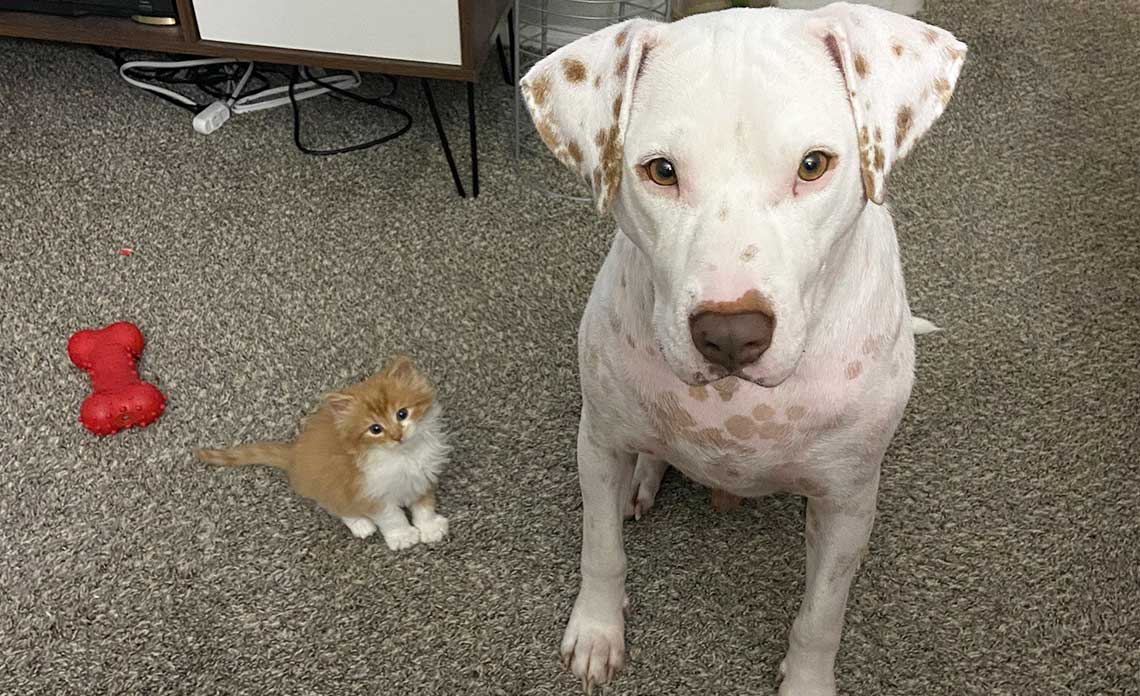Congratulations on the newest addition to your family – a furry friend! Bringing a new pet into your home is a joyful experience filled with excitement and anticipation. While some may harbor concerns about how dogs and cats will coexist, rest assured that with patience, care and an understanding of your pets’ unique personalities, a harmonious living arrangement can be achieved. In this guide, we will provide you with valuable steps to ensure a successful introduction between your new cat and resident dog.
Establish separate spaces
One of the initial steps to a successful introduction is creating dedicated spaces for both your cat and dog. Your cat should have a secure area with essentials like a litter box, scratching post, cozy hideaway, water, food and toys. Meanwhile, your dog should also have a designated space, whether it’s a separate room or a crate, complete with bedding, toys and food/water bowls. This separation allows each pet to feel safe and secure.
Gradual introduction
For the first few days, it’s crucial to let both your cat and dog adjust to the new scents and environment without direct interaction. Swap their spaces intermittently, so they become familiar with each other’s scents. This helps alleviate initial stress and anxiety.
Pre-introduction stimulation
Before the big introduction, ensure that both your dog and cat have had an opportunity for mental and physical stimulation. Walk your dog and engage in playtime to help them expend excess energy. For your cat, offer appropriate play and engagement to reduce anxiety levels.
Introduce one at a time
When it’s time for the initial meeting, introduce the pets one at a time, starting with the more confident pet. Allow your cat to roam freely while keeping your dog securely leashed. Have treats on hand to redirect your dog’s attention if needed. Begin at a distance and use barriers like a baby gate or screen. If your dog fixates on the cat, increase the distance and use treats for redirection.
Facilitate the greeting
If both pets remain calm during the initial encounter, let your dog approach and sniff the cat. Keep your dog leashed during the first few introduction sessions, allowing them to drag the leash for quick intervention in case of chasing behaviors. If the greeting does not go well, give them a break and try again the next day, possibly with increased distance or a barrier. If the interaction goes well, continue to use the leash in subsequent meetings, letting it drag to maintain control if necessary.
Seek professional help if needed
If you encounter difficulties during the introduction process, do not hesitate to seek professional assistance from a positive reinforcement cat trainer or behaviorist. Their expertise can provide valuable insights and strategies to ease the transition.
Helpful tips
Positive associations – Foster positive associations by feeding both pets on opposite sides of the same door, allowing them to associate each other’s smells with a positive experience.
Mingle scents – Brush all pets with the same brush to intermingle their scents, helping to familiarize them with each other’s presence.
Calming aids – Consider using calming collars or diffusers that replicate calming pheromones for both dogs and cats to ease any anxiety or fear.
Patience is key – Understand that successful introductions can take time, ranging from a week to several months, depending on the individual pets involved.
Introducing a new pet to your family can be a rewarding experience, and with the right approach, you can ensure a smooth transition for both your cat and dog. By following these steps and staying patient, you’ll increase the likelihood of a harmonious coexistence between your beloved furry companions. Enjoy the journey of building lasting bonds and cherished memories with your expanded family!
Stay up to date
Follow us on Facebook, Instagram and Twitter for the latest news.





